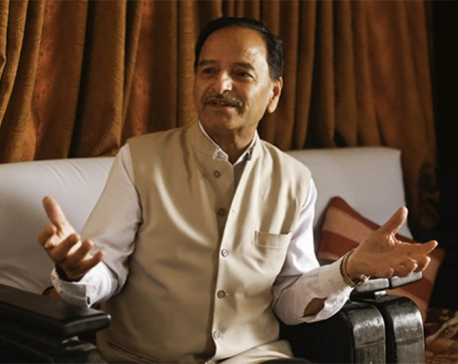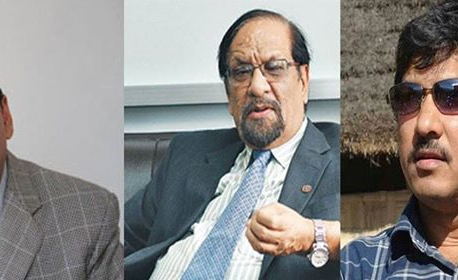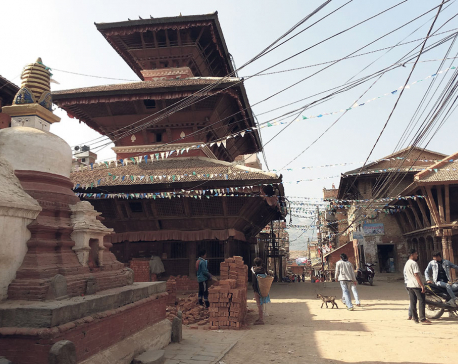
OR
Judging by the popular votes this time for Nepali Congress, communist victory appears nothing more than an outcome of political match-fixing.
Even before the Election Commission publishes its final tally, the people in the media, political party cadres and some arm-chair political analysts are already obsessing over poll results. Basically, these people can be grouped under two camps. With the electoral alliance between the CPN-UML and CPN (Maoist Center) securing two-third majority in the first-past-the-post (FPTP) elections, people in this camp are rejoicing at the hope that Nepal is, finally, poised for a strong and stable government, at least for next five years, and this means peace and prosperity. This sanguine camp sees the bright “Sun” shining all over Nepal. Even the donors are heaving a sigh of relief as they can work peacefully in Nepal if there is stable policy.
Contrast this with hue and cry in another camp. With a humiliating defeat of Congress, they perceive a dark cloud in the sky, and they take this as a severe blow to Nepal’s fledgling democracy. The specter of international donors pulling out of Nepal, reduced FDI, and a strained roti-beti relationship with India deeply haunts them. The defeat of NC equals to defeat of democracy. Even foreign media is projecting Nepal to drift towards China. The mainstream news media and online portals are replete with analysis after analysis on factors leading to spectacular defeat of NC. Some young guns are already demanding leadership change while its leaders keep busy pointing fingers at each other for the antarghat—an enemy within.
The reality is somewhere in between, a bit hazy situation. Anybody who has a knack of dissecting election data will soon realize that the big victory or the doomsday projection no longer holds true. Their perception is squarely based on 60 percent FPTP vote counts plus the rolling of heads of some NC bigwigs. Since we have adopted “a mixed up” electoral system comprising 60 percent FPTP seats and 40 percent PR seats, the analysis must be based on the total counts.
Absurd ‘loss’
Even going by the FPTP published results, one can already see the absurdity in voting outcomes. The NC, which has trailed far behind, securing mere 23 seats in FPTP elections, has secured the highest number of FPTP votes: 3.59 million in total. On the other hand, the CPN-UML, which emerged as the largest party with 80 seats, has secured 3.08 million votes. The Maoist Center, with 36 seats, received 1.51 million. This is possible due to NC filing large number of (losing) candidates compared to CPN-UML or Maoists. However, FPTP vote counts are useful in signaling outcomes in PR vote counts.
At the time of this writing, PR vote counts are still in process. At 9.54 million PR vote count, the respective share of three big parties included: CPN-UML, 3.17 million (33 percent), NC, 3.12 million (33 percent) and Maoist Center 1.30 million (14 percent).Based on the current PR vote counts, I have estimated PR seats to be distributed among three big parties. The full picture is presented in the table alongside.
In 2008 CA elections, the Maoist party turned out to be the largest party, securing 37 percent of total seats. Many believed voters’ inflation, while others believe the use of muscle power. But the reality is that the Maoists themselves were surprised by the poll results. In absence of PR system, they would have formed the government with a simple majority they secured in FPTP vote-count. It is a sheer paradox that a political party that advocated for an inclusive electoral system had the taste of its own medicine.
The CA elections in 2013 changed the relative positions of political parties. Congress emerged as the largest party, securing one-third votes. CPN-UML emerged as the second largest with 30 percent. However, the Maoists were reduced by more than a half—from 37 percent in 2008 to 18 percent in 2013. There could be many factors behind Maoist downfall. But Comrade Prachanda realized the value of being at the margins in a hung parliament-like situation. And he did not fail to take full advantage.
Distant dreams
In the recently concluded elections, UML has emerged as the largest political party, securing 80 out of 165 seats in FPTP votes. But it is still short of a simple majority. Without the support of the Maoists, it cannot form government on its own. So what we see here is a replay of same old game of bhaagbanda and musical chairs, albeit within a limited number of actors due to differences in power balance reflected in poll results. The present hullabaloo on stable government and two-third communist majority arises because of the alliance between UML and Maoists.
As the systems of aalo paalo and bhagbanda are deeply ingrained in our culture, the much-hyped political stability and development are still distant dreams. The picture will be clear when UML and Maoists sit together to share the spoils. Given the musical chair-like situation, as depicted in the Table 1, there is more a possibility of business-as-usual than a real change. The actors and the characters remain the same; only 38 percent of the MPs elected from the FPTP are new faces.
The other hype with communist unification is also dubious. So long as UML and Maoists are not registered as a single party with the Election Commission, they continue to remain distinct. Two factors explain why communist unification is elusive. First, as the data from PR vote count reveals, Maoist popularity is on decline. Given their relative unpopularity, why would UML entertain them? In politics, there are no such things as permanent friends and foes. Moreover, UML has its own constraints: limited rent-seeking capability. The Cabinet size cannot expand beyond 25 ministers. Rt. Honorable President and Vice President are reported to have expressed their desire for second terms. As UML is a cadre-based party, there are hosts of demands from their constituencies, including implementation of their populist agendas.
Second, given the past antagonistic relationship between the two, there is lingering doubt that unification talk is nothing more than propaganda to sway voters. But in the days ahead it will not be a surprise to see them continue to talk up communist unification, even if they are not serious. Rumor market is already rife with news of UML and Maoist power-sharing agreements, implying reverting to the same musical chair, with UML Secretary General saying that party chair, parliamentary leader and PM must be the same person, and an ongoing debate on when party unification would come about, before or after government formation.
It’s complicated
Judging by the popular votes received by NC, it is clear that communist victory is nothing more than an outcome of “political match-fixing”. Oli and Prachanda may have turned out to be great strategists but the longevity of their strategy is very much in doubt.
However, the elections do leave important messages. The recent elections cannot be compared with earlier ones that were organized primarily for drafting the constitution than for governing state agencies. Moreover, we now have provincial and local governments. A reduction in the number of political parties in the parliament together with limitations on filing of no-trust motion is expected to reduce horse trading and jockeying. However, social justice and inclusive agendas are as much intact, perhaps complicated by the domination of Madhesi parties in Province 2.
Poor diplomacy has ruined international relations. Recent flippant remarks by Prachanda that “foreign governments need not worry about communist coming to power in Nepal” is surely not intended to build international support, and especially of the two neighbors, for the new coalition. Realizing its undiminished popularity, NC will be on the prowl, looking for an opportunity to upturn its tactical defeat at the hands of the communist alliance. Who knows, this could even be a blessing in disguise.
You May Like This

Sitaula takes flak for NC's loss in Jhapa
JHAPA, Dec 15: Krishna Prasad Sitaula had transformed himself into an influential leader of the Nepali Congress (NC) through election victories... Read More...

NC’s stronghold in Nuwakot crumbles with Mahat's loss
NUWAKOT, Dec 10: Another senior leader of Nepali Congress succumbed to a defeat in Nuwakot. Dr. Ram Sharan Mahat, former... Read More...

Loss of heritage is loss of living culture
KATHMANDU, Nov 28: The idols of goddess Bal Kumari and Rudryani from the Rudrayani Temple in Khokana was stolen on the... Read More...











Just In
- Challenges Confronting the New Coalition
- NRB introduces cautiously flexible measures to address ongoing slowdown in various economic sectors
- Forced Covid-19 cremations: is it too late for redemption?
- NRB to provide collateral-free loans to foreign employment seekers
- NEB to publish Grade 12 results next week
- Body handover begins; Relatives remain dissatisfied with insurance, compensation amount
- NC defers its plan to join Koshi govt
- NRB to review microfinance loan interest rate








Leave A Comment